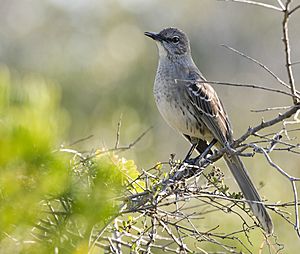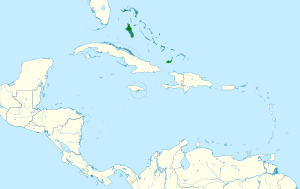Bahama mockingbird facts for kids
Quick facts for kids Bahama mockingbird |
|
|---|---|
 |
|
| In Ciego de Avila Province, Cuba | |
| Conservation status | |
| Scientific classification | |
| Genus: |
Mimus
|
| Species: |
gundlachii
|
 |
|
The Bahama mockingbird (Mimus gundlachii) is a type of bird known for its singing. It belongs to the Mimidae family, which includes other mockingbirds and thrashers.
You can find this bird mainly in the Bahamas, Cuba, Jamaica, and the Turks and Caicos Islands. Sometimes, it even visits Florida as a vagrant, meaning it's usually not found there.
Contents
Bird Family and Name
The Bahama mockingbird has two slightly different types, called subspecies. One is the main type, known as Mimus gundlachii gundlachii. The other is M. g. hillii.
The bird's scientific name, gundlachii, was chosen to honor a person named Juan Gundlach.
What Does the Bahama Mockingbird Look Like?
The Bahama mockingbird is about 28 centimeters (11 inches) long. It usually weighs between 57 and 85 grams (2 to 3 ounces).
Adult birds have a face with a mottled, or spotted, pattern. They have a pale stripe above their eye. Their upper parts are brownish-gray with dark streaks. These streaks run from their head down to their lower back. The outer feathers of their tail have white tips.
Their underparts, or belly area, are light gray. They have light streaks on their upper chest. The streaks on their sides are more noticeable. Young birds look similar but have more spots on their underparts. The M. g. hillii subspecies has more streaks on its back. It also has larger white tips on its tail feathers.
Where Do Bahama Mockingbirds Live?
The main subspecies of the Bahama mockingbird lives in the Bahamas and the Turks and Caicos Islands. It also lives on the Sabana-Camagüey Archipelago off Cuba's north coast. The M. g. hillii subspecies is found only in southern Jamaica.
These birds live in many different places. They can be found near the coast, in dry scrubland, and in open woodlands. They also live in plantations. In Jamaica, they prefer dry, scrubby woodlands on limestone hills.
The Bahama mockingbird seems to like taller, denser plants. This is especially true where it lives near the northern mockingbird (Mimus polyglottus).
How Bahama Mockingbirds Behave
What Do They Eat?
The Bahama mockingbird eats many different things. It is an omnivore, meaning it eats both plants and animals. Its diet includes small insects and other invertebrates. It also eats nectar from flowers, small fruits, and even tiny lizards.
This bird mostly looks for food on the ground. It searches through fallen leaves to find its meals. However, it can also hunt for food up to 6 meters (20 feet) high in plants. Bahama mockingbirds are very protective of their feeding spots.
How Do They Raise Their Young?
The Bahama mockingbird's breeding season usually runs from February to July. On the Cuban islands, it starts in April. Both male and female birds work together to build a nest.
They make a rough, open cup-shaped nest from twigs. They line it with softer materials. The nest is usually placed low in a bush. These birds sing loudly to defend their territory. A female bird usually lays two or three eggs at a time.
What Does Their Song Sound Like?
The Bahama mockingbird has a loud and repetitive song. It sings a series of sudden, varied notes and phrases. It often repeats these sounds. Interestingly, it does not seem to copy the songs of other birds.
Is the Bahama Mockingbird in Danger?
The IUCN (International Union for Conservation of Nature) has evaluated the Bahama mockingbird. They have listed it as a species of "Least Concern." This means it is not currently considered to be at risk of extinction.
The bird is common in the Bahamas and in southern Jamaica. It is also found on some of the small islands off Cuba. As human homes and towns spread, the Bahama mockingbird might face competition from the northern mockingbird.
Images for kids
See also




